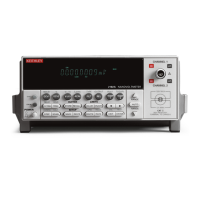I-14 Delta, Pulse Delta, and Differential Conductance
Differential Conductance process
Differential measurements can be used to study the individual slopes of an I-V (or V-I)
curve. By applying a known differential current (dI) to a device, differential voltage (dV)
measurements can be performed. With dI and dV known, differential conductance (dG)
(and differential resistance dR) can be calculated.
This differential measurement process is shown in
Figure I-7. The Model 622x is config-
ured to output a stepped sweep with a specified Delta, which is the differential current
(dI). As shown in the illustration, Delta is added to and subtracted from each subsequent
step in the sweep. The solid line in
Figure I-7 is the actual output of the Model 622x.
As shown, each differential voltage calculation (dV Calc) uses the three previous
Model 2182/2182A A/D measurement conversions. Keep in mind that dI (Delta) is the
same for all calculated points. With dI known and dV calculated, the Model 622x can also
calculate, display, and store the differential conductance (dG) or differential
resistance (dR) for each calculated point.

